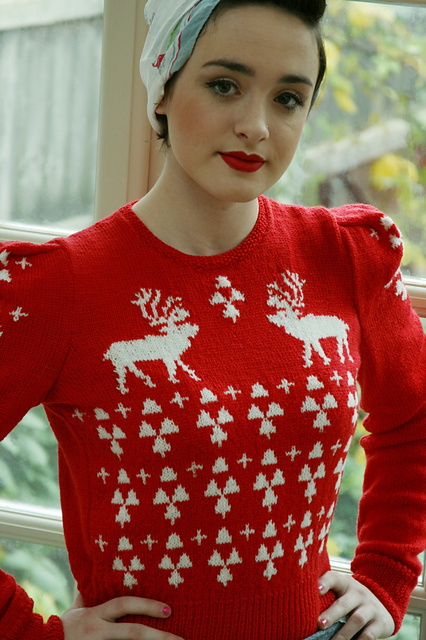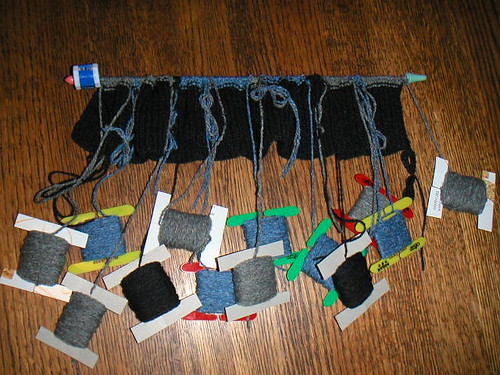Technical Bits: Intarsia
Following on from last week's post about Fair Isle, this time we are looking at another colourwork technique: Intarsia. This method is used when blocks of colour are required, rather than a smaller repeating pattern. A good example of this are the reindeer on The Perfect Christmas Jumper, below.
Motifs are worked with separate balls or bobbins of yarn, producing a garment only one layer thick (rather than Fair Isle's double layer of wool. Before starting to knit, you will need to prepare by winding small balls or bobbins full of each colour to be used. Bobbins are often easier for this, as it makes it easier to untangle the inevitable twisting turning yarns.
As always, knit a swatch up first ...I'm sure that you always knit a tension square anyway, don't you ;) But seriously, knitting a swatch for colourwork knitting is particularly important in order to gauge the tension, and to have a practice of the techniques, if you haven't done it before.
When changing from one colour to another it is best to bring the new colour over the colour you have just finished using. The twists will show up on the purl side of the work (intarsia works best with stocking stitch). Try not to twist the yarns too tightly around each other or the work will look rather pinched, but be careful not to do it too loosely either or you will be left with a hole. This is where the practice swatching really comes into its own.
On the vertical lines of your pattern, you will need to twist the yarns on each row, but on diagonal lines you'll need to only twist on the rows where the yarn colour changes at the same point as it did on the row beneath.
As with Fair Isle patterns, charts are really essential for Intarsia. It is very difficult to follow written-only instructions

 Hearts and Bunnies Cardigan. Image copyright Arbour House Publishing
Hearts and Bunnies Cardigan. Image copyright Arbour House Publishing
If you'd like to try out some Intarsia, you could try one of the following patterns:
The Perfect Christmas Jumper: Ravelry link and Knitonthenet Shop link to the pattern
Hearts and Bunnies Cardigan: Ravelry link and Knitonthenet Shop link to Vintage Gifts to Knit
Happy knitting!
Ingrid x
Motifs are worked with separate balls or bobbins of yarn, producing a garment only one layer thick (rather than Fair Isle's double layer of wool. Before starting to knit, you will need to prepare by winding small balls or bobbins full of each colour to be used. Bobbins are often easier for this, as it makes it easier to untangle the inevitable twisting turning yarns.
As always, knit a swatch up first ...I'm sure that you always knit a tension square anyway, don't you ;) But seriously, knitting a swatch for colourwork knitting is particularly important in order to gauge the tension, and to have a practice of the techniques, if you haven't done it before.
When changing from one colour to another it is best to bring the new colour over the colour you have just finished using. The twists will show up on the purl side of the work (intarsia works best with stocking stitch). Try not to twist the yarns too tightly around each other or the work will look rather pinched, but be careful not to do it too loosely either or you will be left with a hole. This is where the practice swatching really comes into its own.
On the vertical lines of your pattern, you will need to twist the yarns on each row, but on diagonal lines you'll need to only twist on the rows where the yarn colour changes at the same point as it did on the row beneath.
As with Fair Isle patterns, charts are really essential for Intarsia. It is very difficult to follow written-only instructions

 Hearts and Bunnies Cardigan. Image copyright Arbour House Publishing
Hearts and Bunnies Cardigan. Image copyright Arbour House PublishingIf you'd like to try out some Intarsia, you could try one of the following patterns:
The Perfect Christmas Jumper: Ravelry link and Knitonthenet Shop link to the pattern
Hearts and Bunnies Cardigan: Ravelry link and Knitonthenet Shop link to Vintage Gifts to Knit
Happy knitting!
Ingrid x
Labels: colourwork, intarsia, technical bits, Vintage Gifts to Knit









0 Comments:
Post a Comment
<< Home